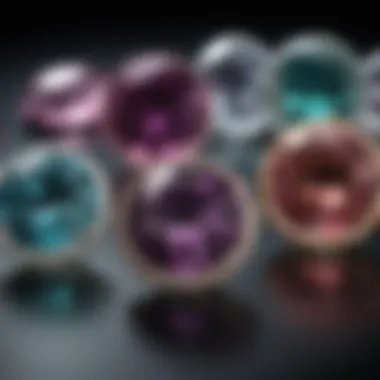Understanding Alexandrite Stone Pricing: A Comprehensive Guide


Intro
Alexandrite is a stunning gemstone, famed for its color-changing abilities. The journey to understand its pricing involves delving deep into various elements. To appreciate how value is derived, one must examine factors such as rarity, quality, and shifting market trends. Each of these components plays a crucial role in how collectors, jewellers, and enthusiasts perceive and value alexandrite.
In this guide, we will explore the essential aspects of alexandrite, providing insights into what makes this gemstone unique. Whether you are a potential buyer or simply interested in gemstones, this analysis will enhance your understanding of the complexities behind alexandrite pricing.
Gemstone Overview
Description of the gemstone
Alexandrite is a variety of the chrysoberyl mineral that exhibits a remarkable phenomenon: color change. Depending on the light source, it can appear green in daylight and red under incandescent light. This unique trait makes it one of the most coveted gemstones in the market. Originating from locations like Brazil, Russia, and Sri Lanka, its rarity only enhances its allure.
Physical properties
Understanding the physical properties of alexandrite can provide insight into its value. Here are some key characteristics:
- Hardness: Ranks 8.5 on the Mohs scale, contributing to its durability.
- Crystal system: Trigonal, which affects its optical properties.
- Specific gravity: Between 3.67 and 3.73, which signifies its density.
- Refractive index: Approximately 1.744 to 1.755, affecting how light interacts with the stone.
These properties not only affect its use in jewelry but also influence factors like pricing and rarity.
"The unique color change and physical properties create a high demand, especially in the luxury market."
Healing Properties
Metaphysical attributes
In addition to its beauty, many believe that alexandrite possesses healing properties. It is often associated with balance and transformation. Some claim that it can help with emotional clarity, making it a favorite among those interested in metaphysical benefits.
Common uses in holistic practices
Alexandrite is utilized in various holistic practices. These may include:
- Meditation aids: Practitioners often use alexandrite to reach deeper states of meditation.
- Energy healing: Some healers apply alexandrite to balance energies within the body.
- Intentions and manifestations: Due to its supposed connection to transformation, many use it in rituals aimed at manifesting change.
These attributes add yet another layer to the stone's value, making it appealing to both gem enthusiasts and alternative healing practitioners.
Prelims to Alexandrite
Alexandrite is not just a gemstone; it represents a complex interplay of rarity, beauty, and market dynamics. Understanding this stone’s pricing is essential for anyone involved in the gemstone trade or collecting. Alexandrite is prized for its unique color-changing property, shifting from green in daylight to red under incandescent light. This captivating characteristic not only enhances its desirability but also complicates valuation. The significance of comprehending its pricing lies in making informed decisions, whether you're an investor, a jeweler, or an enthusiastic collector.
Anticipating price fluctuations can be advantageous. As those interested in gemstones explore the fine nuances of alexandrite, knowledge of its historical context and physical properties becomes crucial. This section lays the groundwork to appreciate why alexandrite holds a special place in the gem world and how its value is determined.
The History of Alexandrite
Alexandrite was first discovered in the Ural Mountains of Russia in the early 19th century. It was named after the future Tsar Alexander II to celebrate his coming of age. This stone became a symbol of royalty, enhancing its allure. After its initial discovery, alexandrite quickly gained popularity not only in Russia but also throughout Europe and America. The stone's tale is intertwined with historical events, such as the discovery of the first deposits during the Napoleonic wars, which added a level of intrigue to its provenance. As mining in Russia diminished, sources in Brazil and later in Sri Lanka began to supply the demand, but the scarcity from its original location continued to drive prices higher. The historical importance of alexandrite underscores its cultural value, significantly influencing its pricing in today’s market.
Physical and Optical Properties
The physical and optical properties of alexandrite contribute substantially to its pricing.
- Color Change: The most notable feature is its ability to change color under different lighting. This phenomenon results from the unique crystal structure of chrysoberyl, the mineral from which alexandrite is formed.
- Clarity: High-quality alexandrite stones often exhibit exceptional clarity with few inclusions. Stones with visible inclusions are generally less valuable.
- Cut: The quality of the cut can drastically affect how the stone appears under varying lighting. Well-cut stones better display the optical effects and color change, thereby increasing their appeal and value.


Understanding these elements aids buyers and sellers in navigating the complex gem market. The combination of history and the unique physical properties places alexandrite among the top-tier gemstones worthy of investment, setting a high standard for valuation.
Factors Influencing Alexandrite Prices
Understanding the factors that affect the pricing of alexandrite is essential for both buyers and enthusiasts. Alexandrite, being a rare gemstone, presents a unique set of variables that determines its market value. Knowledge of these elements can help potential buyers make informed decisions and avoid common pitfalls. By delving deep into the important attributes forming the basis of pricing, one can appreciate the complexities of this precious stone.
Rarity of Alexandrite
Rarity is arguably the most significant factor impacting the price of alexandrite. This gemstone ranks highly on the scale of scarcity, which inevitably boosts its value. The stones of high-quality alexandrite can be difficult to find. Natural stones, especially those with exceptional color change effects, are even rarer. Most of the alexandrite stones found in the market today come from specific deposits in Russia, Brazil, and Sri Lanka.
The supply of alexandrite is limited due to the challenges associated with mining these stones. With demand steadily increasing, the rarity factor plays a crucial role in driving prices higher. Collectors and buyers recognize that acquiring quality alexandrite involves careful consideration since obtaining these stones often leads to premium pricing.
Color Change Phenomenon
The unique color change property of alexandrite is a pivotal factor that influences its pricing. Alexandrite exhibits a remarkable ability to shift colors under different lighting conditions. Generally, it appears greenish-blue in daylight and tends toward a more reddish-purple color under incandescent light. This exceptional optical characteristic tremendously enhances the gemstone's allure.
High-quality alexandrite, which displays strong and vibrant color changes, commands significantly higher prices than its lower-quality counterparts. Buyers are particularly keen on stones that showcase dramatic and noticeable shifts. For connoisseurs, the intensity and quality of the color change can elevate the stone's value.
Clarity and Cut Quality
Clarity and cut quality are critical perceptions in determining the value of an alexandrite stone. Clarity reflects the presence of inclusions or blemishes within the stone. Ideally, high-quality alexandrite should be eye-clean, having no noticeable inclusions visible to the unaided eye. Stones with fewer inclusions are more desirable, thus affecting the overall pricing.
The cut quality also influences both the aesthetics and the brilliance of alexandrite. A well-cut stone will reflect light more effectively, enhancing its visual appeal. Conversely, poorly cut stones might appear dull or lifeless, impacting their market value negatively. Cut quality is evaluated based on symmetry, proportions, and polish, each of which can add significant worth to the gemstone.
In summary, rarity, color change phenomenon, and clarity and cut quality are critical factors that significantly influence alexandrite prices. Understanding these factors can aid in making informed purchasing decisions.
Market Dynamics and Pricing Trends
Understanding the market dynamics and pricing trends of alexandrite is essential for anyone interested in acquiring this captivating gemstone. The interplay of various elements shapes the price of alexandrite, making awareness of current conditions crucial. These dynamics not only reflect the intrinsic qualities of the stone but also respond to external factors that influence supply and demand.
Current Market Overview
The current market for alexandrite showcases a mixture of stability and fluctuation. Prices are influenced by the quality of the stones, rarity, and market demand. As of now, high-quality alexandrite—particularly those with pronounced color change properties and minimal inclusions—are highly sought after. According to reports, the price for premium stones can reach up to several thousand dollars per carat, reflecting both desirability and exceptional quality. Collectors and investors alike have noticed that excellent specimens have maintained or even increased in value over time.
Supply and Demand Factors
Several factors influence the supply and demand of alexandrite. One of the key aspects is its rarity; natural alexandrite is scarce, particularly ones exhibiting significant color change. Mining sources are limited to regions like Cruzeiro in Brazil and parts of Russia, making consistent supply a challenge.
- Increase in Demand: There has been a growing interest in unique gemstones, with more enthusiasts and collectors joining the market. This rising trend in gemstone appreciation drives demand upwards.
- Limited Supply: New findings of alexandrite deposits are rare, meaning existing sources are become more depleting. This naturally restricts the availability of high-quality stones on the market.
The balance between these supply and demand factors frequently leads to price speculation. Buyers might find it worthwhile to invest during times of increased demand when the value of stones could climb significantly.
Impact of Online Sales on Pricing
The emergence of online platforms for buying and selling gemstones significantly affects pricing strategies and market access. Consumers can now browse a broader array of alexandrite listings from international sellers and can compare prices easily. This openness benefits buyers but can challenge traditional brick-and-mortar stores.
- Price Transparency: Online marketplaces enhance transparency, allowing buyers to gauge fair market values and make informed decisions. It educates them on essential pricing metrics and aspects of quality.
- Direct Access: Sellers can reach a global audience, impacting how prices are set. However, the convenience may lead to price fluctuations as sellers might adjust pricing strategies to compete with global listings.
- Trust and Verification: Buyers must navigate the complexities of online shopping by ensuring the credibility of sellers. This includes verifying appraisals and understanding the condition and qualities of the stones.
The dynamics of online sales have transformed the overall landscape of gemstone trading. Awareness and familiarity with this market can provide both buyers and sellers with greater opportunities.
In summary, the market dynamics and pricing trends of alexandrite are influenced by various factors including current market conditions, supply and demand, and the rise of online sales. Understanding these components allows collectors and potential buyers to make informed decisions when investing in this rare gemstone.


Evaluating Alexandrite Quality
Evaluating the quality of alexandrite is crucial for understanding its price and value in the market. Alexandrite, known for its unique color-changing properties and rarity, demands careful examination. Buyers, collectors, and investors benefit from comprehensively understanding grading systems, color quality, and overall characteristics of this gemstone. Each aspect plays a significant role in determining how the stone is valued, and therefore, proper evaluation is necessary for informed decision-making.
Grading Systems for Alexandrite
Grading systems are frameworks used to assess the quality of gemstones, including alexandrite. These systems evaluate multiple characteristics such as color, clarity, cut, and carat weight. The GIA, or Gemological Institute of America, is a widely respected organization that provides certification and grading for gemstones. Triaging quality can help determine whether the stone fetches a higher or lower price on the market.
Key factors in grading include:
- Color: Alexandrite is known for its striking green hue in daylight and reddish-purple under incandescent light. Grading depends on the richness and intensity of these colors.
- Clarity: Clarity refers to the presence of inclusions or internal flaws. A higher clarity rating, which implies fewer visible inclusions, generally signifies a higher value.
- Cut: The quality of the cut impacts how light interacts with the stone. A well-cut alexandrite will enhance its beauty and appeal.
- Carat Weight: Heavier stones are rare, and larger sizes tend to be more valuable.
Understanding these grading criteria allows buyers to make more educated choices, especially concerning pricing.
Color Quality and Its Impact on Value
Color quality is one of the most vital factors in determining the value of alexandrite. The striking ability of alexandrite to change colors is not just a novelty; it significantly influences its desirability among buyers. Ideally, a high-quality alexandrite should have a distinct and rich color in both lighting conditions (daylight and incandescent).
- Color Variation: Stones that exhibit a vibrant, distinct contrast between their daylight and incandescent colors typically demand higher prices. The more pronounced the change, the more valuable the stone may be.
- Saturation and Tone: The saturation and tone of the colors also impact value. A strong saturation of both colors, combined with a medium tone, is generally preferred and commands a better price.
Alexandrite's color quality sets it apart from other gemstones. This unique property enhances its appeal as a collector's item, and therefore, its market value is significantly influenced by these characteristics.
"The beauty of alexandrite lies not just in its rarity but also in the spectacular dance of color it performs under different lights."
Understanding the nuances of color quality in alexandrite gives buyers a strategic advantage when searching for valuable pieces in this intricate market.
Gathering and Analyzing Price Data
When it comes to determining the value of alexandrite, gathering and analyzing price data is crucial. This process allows buyers, collectors, and enthusiasts to understand market value and make informed decisions. Alexandrite prices can fluctuate based on various factors, including quality, rarity, and market demand. By collecting accurate data, one can effectively gauge what constitutes a fair price for this unique gemstone.
The importance of analyzing price data lies in its role in transparency. Potential buyers can see price trends over time. This knowledge helps to avoid overpaying for a stone. Additionally, it provides insights into variations across different regions and sellers. Educated decisions can enhance the buying experience and ensure satisfaction with the purchase.
Collecting Data from Various Sources
To effectively analyze alexandrite pricing, one must collect information from several reliable sources. Various platforms provide valuable price insights:
- Online Marketplaces: Websites like eBay and Etsy often showcase real-time listings that include current asking prices for alexandrite gemstones. This can reveal how prices differ based on quality, size, or seller reputation.
- Gemological Institutes: Institutions such as the Gemological Institute of America (GIA) offer resources and reports that list estimated values based on grading. Their expertise helps in understanding what a stone is worth based on its attributes.
- Forums and Community Discussions: Platforms like Reddit have groups dedicated to gemstones. Discussions in these areas can provide anecdotal price data and firsthand experiences from buyers and collectors. Engaging with these communities can also offer negotiation strategies and seller recommendations.
Collecting data from a diverse range of sources will create a well-rounded view of current pricing trends. It's advisable to keep track of prices over time, creating a reference guide that can aid direct future purchases.
Understanding Appraisal Processes
Understanding how appraisals work is an important aspect of assessing alexandrite price. Appraisal involves a professional evaluating the stone based on specific criteria. Typically, gem appraisers consider:
- Quality of Stone: This includes examining color, clarity, cut, and carat weight. Higher quality stones with strong color change and minimal visible inclusions will yield better appraisals.
- Market Relevance: Appraisers will take current market demand into account. A stone that fits popular trends might have a higher appraisal value.
- Documentation and Certification: Having certification from reputable grading organizations can significantly affect a stone's perceived value. Buyers should look for appraisals that come with proper documentation.
The appraised value can sometimes differ from the asking price in the market. It is wise to consult multiple appraisers to ensure you get a fair assessment.
Tips for Purchasing Alexandrite
When considering the purchase of alexandrite, understanding its complex market is essential. This unique gemstone has strong emotional and financial value. Thus, acquiring it requires knowledge and caution. In this section, we will explore key elements that can assist buyers in making informed choices.


Identifying Reputable Sellers
Purchasing alexandrite should begin with identifying trustworthy sellers. Not all sellers provide the same level of quality or transparency. It is vital to examine a seller’s reputation before making a decision. Here are some steps to guide this process:
- Research Online: Check platforms like Reddit or specialized jewelry forums for reviews and experiences shared by other buyers. Look for testimonials that highlight both positive and negative experiences.
- Verify Credentials: Ensure that the seller has proper certifications. Accredited dealers should have certifications from recognized gemological institutions. This can assure you of the gemstone's authenticity and value.
- Ask Questions: Don't hesitate to inquire about the origin of the stone, its treatment, and grading. A reputable seller will be willing to answer your questions and provide you with all necessary information.
In-depth research on sellers enhances your chances of obtaining high-quality alexandrite at a fair price. A well-informed customer is less likely to fall victim to poor purchases.
Negotiating Prices
Once you find a reputable seller, the next step is price negotiation. This is an important part of buying alexandrite, as the price can vary significantly depending on the seller. Here are some tips to negotiate effectively:
- Know the Market Value: Inform yourself about current alexandrite price trends. Reference platforms such as en.wikipedia.org for general pricing and trends. Knowing high and low price points will provide leverage during negotiation.
- Be Respectful but Firm: Approach the negotiation with respect for the seller's position. State your reasons for requesting a lower price calmly. Sellers often appreciate courteous discussions and may be more flexible in adjustments.
- Consider Package Deals: If you're interested in multiple stones or pieces, ask if there are any package deals or discounts available. Sellers may offer better pricing for bulk purchases.
Effective negotiation not only brings down the cost but also establishes a good relationship with the seller, potentially benefiting future transactions.
Long-term Value and Investment Potential
When considering the purchase of Alexandrite, it is essential to understand the long-term value and investment potential associated with this unique gemstone. Alexandrite is not only a visually striking stone; it is an asset that can appreciate in value over time. The intersection of rarity, quality, and market trends makes it a captivating investment for enthusiasts and collectors.
One key aspect to consider is the rarity of high-quality Alexandrite. As mentioned previously, the availability of genuine stones in the market is limited. This scarcity can drive up prices, making well-preserved or high-grade specimens valuable over time. Additionally, the color-changing property of Alexandrite makes each stone unique, adding to its allure and investment worth.
Investors and collectors should also be aware of the market trends that affect gemstone pricing. Factors such as economic fluctuations, consumer interests in natural gemstones, and trends in jewelry design can create volatility in prices. However, stones that are of superior quality, particularly those with strong color change, often maintain their value better than those of lower quality.
Market Trends and Future Predictions
As the market for gemstones evolves, so do the trends that dictate pricing. Currently, there is a growing appreciation for natural stones, driven by a consumer desire for authenticity and uniqueness. This shift in consumer behavior has begun to favor Alexandrite, especially as more people become informed about its distinct properties.
Predictions for the future indicate an upward trend in the value of Alexandrite. The increasing demand, paired with its diminishing supply, suggests that well-sourced Alexandrite will see sustained market interest. Moreover, as more jewelry designers incorporate this stone into luxury collections, its appeal is likely to broaden, thus enhancing its valuation.
Key Points on Market Trends:
- Demand for authentic experiences favors natural gemstones.
- Economic growth in emerging markets may boost luxury purchases.
- Sustainability trends encourage the purchase of ethically sourced stones.
Collectibility and Alexandrite
The collectibility of Alexandrite is intrinsically linked to its unique characteristics. Serious collectors appreciate stones not only for their beauty but also for their investment potential. The historical significance and rarity establish Alexandrite as a coveted addition to any collection.
When evaluating collectibility, several factors come into play:
- Provenance: Stones that have documented histories or ownership by notable collectors can command higher prices.
- Quality: The superior clarity, cut, and color play vital roles in determining a stone's collectibility.
- Trends: Collectors often seek pieces that reflect current trends or have forecasting potential. As interest in Alexandrite grows, its desirability among collectors is expected to increase.
"The rarity of high-quality Alexandrite will likely keep demand strong as collectors seek unique pieces that stand out in their portfolios."
For further insights and discussions, visit Wikipedia, Britannica, and communities on Reddit discussing gemstone investments.
Epilogue
The conclusion serves as an essential closing segment in this comprehensive guide to understanding alexandrite stone pricing. It synthesizes important insights acquired throughout the article, helping readers grasp the multifaceted nature of alexandrite's market value.
In this section, it is crucial to reaffirm the concepts of rarity, quality, and market dynamics. These elements dictate how pricing is established and fluctuate over time. A thorough understanding of these factors allows gemstone enthusiasts, collectors, and jewelry designers to make informed decisions.
Additionally, the conclusion offers an opportunity to emphasize the significance of due diligence when purchasing alexandrite. Knowledgeable buyers can discern quality and authenticity, making it more likely for them to secure valuable investments.
As the market continues to evolve, staying informed about trends can also be beneficial. This knowledge empowers buyers to assess the long-term potential of their investments in alexandrite stones.
Summarizing Key Takeaways
- Rarity and Value Connection: Rarity plays a pivotal role in pricing. The fewer the stones available, the higher their desirability.
- Quality Assessment: Stone quality factors, such as clarity and cut, significantly influence value. High-quality stones fetch premium prices.
- Market Trends: Current market dynamics, including supply and demand, impact pricing strategies.
- Investment Potential: Alexandrite can be a good long-term investment if market trends and personal affinity align.
- Research and Knowledge: Awareness of reputable sellers and negotiation techniques can improve the buying experience and outcomes.







